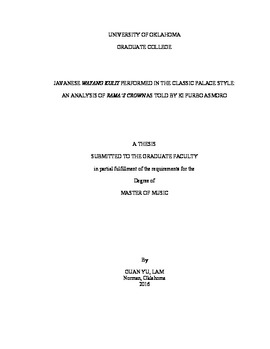| dc.description.abstract | The wayang kulit is the most widespread form of wayang (theatrical play/performance) in Indonesia, and is considered to be one of Indonesia’s highest art forms. In the modern Indonesian language, wayang can be translated to mean “performance,” and kulit to “skin”—with reference to the leather material out of which wayang kulit puppets are made. Wayang kulit is performed by a single puppeteer (known as the dhalang) accompanied by the gamelan orchestra (the traditional orchestra of Indonesia) behind a wide translucent screen. A light source (e.g. a lamp), positioned on the same side as the dhalang, causes shadows cast by the wayang kulit puppets to fall onto the wide screen. For this reason, the wayang kulit is also known as the “shadow puppet play.”
As the oldest Indonesian theatrical art form that has been around since pre-Sanskrit times, the wayang kulit is an important art form familiar to most (if not all) Indonesians. The United Nation’s Educational Scientific and Cultural Organization (UNESCO) recognized the wayang kulit for its cultural significance, excellence, and importance by designating it as a “Masterpiece of the Intangible of Humanity” on the 17th of November, 2003. The Hindu epics Ramayana and Mahabharata are important subject matters for the wayang kulit, despite its pre-Sanskrit existence.
Rama’s Crown (Makutharama) is a Javanese-created play that contains elements of both the Ramayana and Mahabharata epics. Due to the absence of a script for dhalangs to follow strictly, the success of a performance is largely dependent on the improvisational skills, knowledge and mastery of the dhalang. As such, wayang kulit viewers would choose to go to a performance depending on who was the dhalang instead of what the show’s subject matter was going to be. For this thesis, I have selected the performance of Rama’s Crown by world-renowned dhalang, Ki Purbo Asmoro, to be analyzed.
Wayang kulit has traditionally been performed in both formal (e.g. court/palace) and informal (e.g. village) settings. Today, three wayang performance styles are predominant: klasik (classical), garapan (contemporary-interpretive), and padat (condensed). For the purpose of this thesis, only the classic palace style performed by Ki Purbo Asmoro, following the tradition of various dhalang court schools in the 1920s and 1930s, and transcribed/recorded by Kathryn Emerson, will be analyzed. This thesis aims to discover the purpose of music in Javanese Wayang Kulit, and how music is used in the classic palace style performance of Rama’s Crown, as told by Ki Purbo Asmoro. | en_US |
